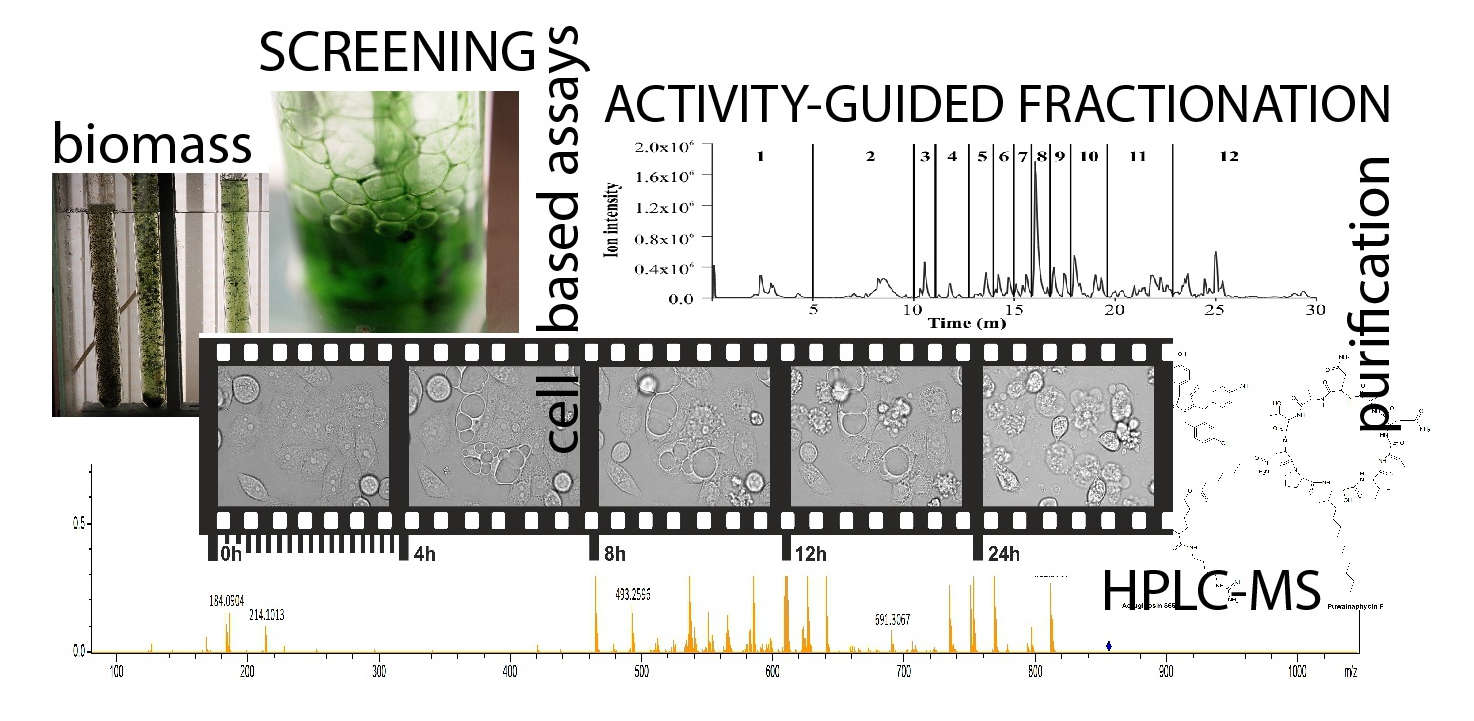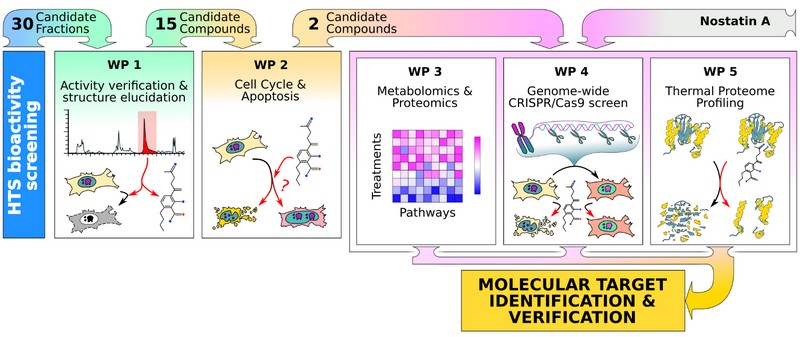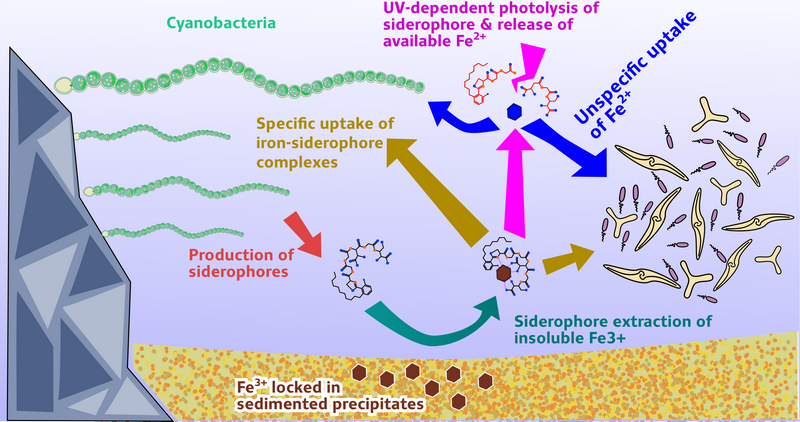Laboratory of algal biotechnology
Pavel Hrouzek's group
Bioactive compounds
Bioactive compounds from cyanobacteria
 Cyanobacterial produce amazing diversity of low-molecular metabolites mostly via the involvement by highly combinatorial biosynthesis pathways. These metabolites are believed to be tuned by evolution to interact with various biological targets and thus many of these structures are applicable in pharmacology and biotechnology. Aside from their pharmaceutical potential these molecules can act as relevant environmental toxins or can provide the cyanobacterium benefits in resource competition. Biosynthesic pathways of these compounds are encoded in biosynthetic gene clusters which facilitates the possible genome screening for novel secondary metabolites of genetic manipulation of these cluster for generation of novel chemical structures.
Cyanobacterial produce amazing diversity of low-molecular metabolites mostly via the involvement by highly combinatorial biosynthesis pathways. These metabolites are believed to be tuned by evolution to interact with various biological targets and thus many of these structures are applicable in pharmacology and biotechnology. Aside from their pharmaceutical potential these molecules can act as relevant environmental toxins or can provide the cyanobacterium benefits in resource competition. Biosynthesic pathways of these compounds are encoded in biosynthetic gene clusters which facilitates the possible genome screening for novel secondary metabolites of genetic manipulation of these cluster for generation of novel chemical structures.
Our research group focuses on interaction on cyanobacterial metabolites with human cells from both pharmacological and toxicological point of view. In a broader context we are interested in the distribution of these metabolites in various habitats and their function in the ecosystem.
Screening for cyanobacterial secondary metabolites for their anticancer potential
There is a sustained need for development of new therapeutics due to poor prognosis of some cancer types and acquired resistance to drugs in clinical use. Microorganisms are an extremely valuable source of bioactive compounds with many having clinical applications. One of the key feature of the functional anticancer drug is the triggering the apoptosis (a way of regulated cell death) in the target cancer cells. Over past ten years we have performed a number of screening of cyanobacterial extracts and extract-derived fractions to find-out novel potential hit-compounds for further studies. We have obtained several novel chemical compounds (e.g. first natural oxadiazine nocuolin a) that induce apoptosis in cancer cells. In the most recent screening performed in collaboration with screening facility CZ-Openscreen we have evaluated bioactivity profiles of cyanobacterial fraction-derived library (1 600 individual fractions) in 18 human cancer cells together with 3 primary or near-primary cell lines in order to retrieve compound with selective anticancer activity. As the knowledge of the exact molecular target of the anticancer drugs is essential for its future applicability we are currently setting up in collaboration with our partners the methodological platform to uncover the mode of action and molecular targets of the newly discovered compound in our laboratory. This are employing the combination of molecular biology, genomics, metabolomics and analytical chemistry, most notably, thermal proteome profiling and genome wide CRISPR-Cas9 screening. The acquired knowledge will be essential for future preclinical testing.
 Colaboration with:
Colaboration with:
- Prof. Andreas Villunger (Univerity of Innsbruck, Austria)
- Dr. André Mueller (Centre for molecular medicine in Vienna, Austria)
- Dr. Dort Avni (MIGAL research Institute, Izrael)
- Dr. David Sedlák (CZ-Openscreen)
Currently running project: Discovery of promissing chemotherapeutic candidates in cyanobacteria using high-throughput screening: mode of action and molecular targets.
If you are interested in this topic, please contact: RNDr. Pavel Hrouzek, Ph.D. (hrouzek@alga.cz, +420 384 340 470).
Potential therapeutics or environmental toxins
Thanks to the extensive research in the field of toxic cyanobacterial secondary metabolites over the last decades, several cyanobacterial toxin groups have been described in more detail, particularly hepatotoxic: microcystins and cylindrospermopsin, and neurotoxins including anatoxins and saxitoxins. However, given the enormous structural diversity of cyanobacterial metabolites and high concentrations of these chemical in cyanobacterial biomass it is likely that some of these structures may be relevant from ecotoxicological point of view.
Cyanobacterial lipopeptides
During our previous surveys of cytotoxic activity of cyanobacterial extracts, we have noted that some cyanobacterial strains are rich in production of cyclic lipopeptides exerting non-specific cytotoxic activity. We have consequently characterized the chemical structure of novel cyanobacterial lipopeptides puwainaphycins isolated from several soil and benthic cyanobacteria and demonstrated their amhiphilic structures cause rapid membrane damage and subsequent cell death in vitro. Aside from the cytotoxic effect puwainaphycins also exerts inhibition effect on several fungi including several important plant pathogens. Surprising is the chemical diversity produced by the individual cyanobacterial strains. The particular variants differ largely in the length of incorporated fatty acid and its functionalization. This structural diversity motivated us to study the structure activity relationships in puwainaphycin natural variants and chemically modified analogues.
In this topic we are interested in following research questions:
- Can puwainaphycins act as environmental toxins or they can be utilized as potential antifungal drugs?
- How do the structural features affect the cytotoxic and antifungal activity
- What is the distribution of cyanobacterial lipopeptides in natural habitat?
If you are interested in this topic, please contact: RNDr. Pavel Hrouzek, Ph.D. (hrouzek@alga.cz, +420 384 340 470).
Cyanobacterial beta-hydroxy aspartate lipopeptides

Iron is an important co-factor to many metabolic enzymes and an essential micronutrient to all known organisms. Due to specific chemical properties of iron and the prevalent oxidative conditions on our planet this abundant element is often present in generally insoluble and poorly biologically available forms. To ensure a supply of iron, microorganisms have evolved several strategies, including the production and excretion of siderophores - low molecular weight compounds that are able to pick up even trace amounts of iron from the environment, facilitate cellular iron uptake and prevent iron conversion to non-bioavailable forms. Similarly as in other organisms (e.g. actinobacteria), the widespread occurrence of siderophores can be expected in cyanobacteria, yet intriguingly only a few such compounds have been described so far. Recently we have identified a novel class of cyanobacterial siderophores - named cyanochelins - and provided data that suggest their frequent occurrence across the phylum.
In microbial communities the siderophores may mediate complex relationships. The siderophores have the potential to efficiently monopolize iron resources for the producer. On the other hand some members of the microbial community were shown to dependent on the supply of siderophores produced by others or it was shown that the siderophores are likely a currency in which bacteria pay to algae or plants for assimilates. We focus on photolabile siderophores thought to be frequent in cyanobacteria. Apart from extraction of iron from poorly available sources these siderophores, once exposed to UV-light, can also undergo photolysis accompanied by release of biologically readily available iron in its Fe2+ form.
We aim to explore the impact of the photolability of iron-siderophore complexes on the iron uptake rate by the siderophore producer and other members of the microbial community. We expect that a considerable amount of photoreduced Fe is leaked from the specific siderophore trafficking to the benefit of other organisms in the producer's vicinity. We aim to quantify the leak and identify the beneficiary. Why would cyanobacteria, the obligate phototrophs destined to live on and out of light, produce photolabile siderophores if not for some symbiotic partner(s)? Who are the partners and what, if anything, do the cyanobacteria get in return? Those are the primary questions fueling our scientific interest.
Scientific collaborations in this topic:
- Dr. Jan Mareš (Institute of Hydrobiology, České Budějovice)
- Dr. Roman Hobza (Institute of Biophysics, Brno)
This topic is covered by recently running GACR project: "Iron monopolization versus community service: two faces of cyanobacterial beta-hydroxy aspartate lipopeptides"